The Context
The early booster sets released in the TCG were full of a variety of largely unrelated cards. This changed with the release of Legacy of Darkness in early 2003. The set contained the first wave of dedicated type based support. This was followed up in the next booster set, Pharaonic Guardian, with the first dedicated support for Zombies. While the support in this set would lay the groundwork for Zombie decks going forward, the deck didn't start seeing competitive play quite yet.
The thing that would push Zombies over the edge into the meta was the release of the infamous Chaos monsters. Zombies worked well within a meta defined by Chaos decks because of their combination of powerful Dark monsters and ability to deal with the Graveyard. While they wouldn't leave too huge of a mark on the pre-Forbidden List meta, the Zombie deck definitely saw play at regionals and as a side deck engine in the normal Chaos decks of the time. However, once the introduction of the Forbidden happened, the competitive scene opened up to the possibility of more diverse decks being able to be played.
The Forces of the Undead
Although Zombies had specific support, this support was much narrower and more generic than later dedicated archetypes would be. Regardless, there were a core of cards shared by almost all Zombie decks used in 2004 and 2005. The first of these was Pyramid Turtle. While floating monsters such as Mystic Tomato and Shining Angel had seen competitive play for some time, Pyramid Turtle took this a step further. Unlike the basic attribute floaters like Mystic Tomato, Pyramid Turtle could Special Summon almost any of the main Zombie monsters in use at the time, including those that would otherwise require a tribute to summon. The ability to get out extremely powerful monsters without using up resources was the first major factor in why Zombies had a competitive edge.
The most used of these powerful monsters was Vampire Lord. With its 2000 ATK and ability to bring itself back from the Graveyard unassisted as well as generate further advantage when it inflicted damage, Vampire Lord was an absolute staple for all early Zombie decks. It's on damage effect was especially potent during the 2005 Goat format because of the deck building trend towards only using 1 copy of most cards, whether by choice or because they were Limited. It was most common at the time to call Spell upon activating Vampire Lord’s effect as all of the most powerful spells of the format, outside of Scapegoat, Book of Moon and Metamorphosis, were Limited to one copy each.
The other major high level Zombie that saw use was Ryu Kokki. While this card came out in the booster set after Vampire Lord, it didn't see the same level of use, only becoming more widespread in Zombie decks near the end of 2005. This was due to Ryu Kokki being particularly powerful against decks that focused on warriors, a deck type that rose to the top of the meta after the September 2005 Forbidden/Limited List made the more generic Goat Control and Chaos decks of the past year less playable.
In addition to these high level monsters, Zombies also had access to a classic creature that had seen competitive usage since the days of Hand Control: Spirit Reaper. While Spirit Reaper had remained a popular card across the board, no deck at the time could use it as efficiently as Zombies with their ability to summon it directly from the deck as well as easily bring it back from the Graveyard.
This grave recursion was facilitated by perhaps the most integral Zombie card: Book of Life. Book of Life served to both allow Zombies to maintain boards of powerful monsters while at the same time disrupting their opponents. This Graveyard disruption was especially powerful in the Chaos heavy metas that persisted from 2004 to 2006. Book of Life was also somewhat notable at the time for having two different distinctly powerful effects, something that was relatively rare for cards in the early game.
Zombie Chaos Decklist
While Zombies were definitely present in the 2005 Meta, they didn’t get a particularly large number of tops, this mostly being due to Shonen Jump Championships at the time only having a Top 8 cut. That being said, the first true Goat Format Shonen Jump Championship was won by Eric Wu’s Zombie Chaos.
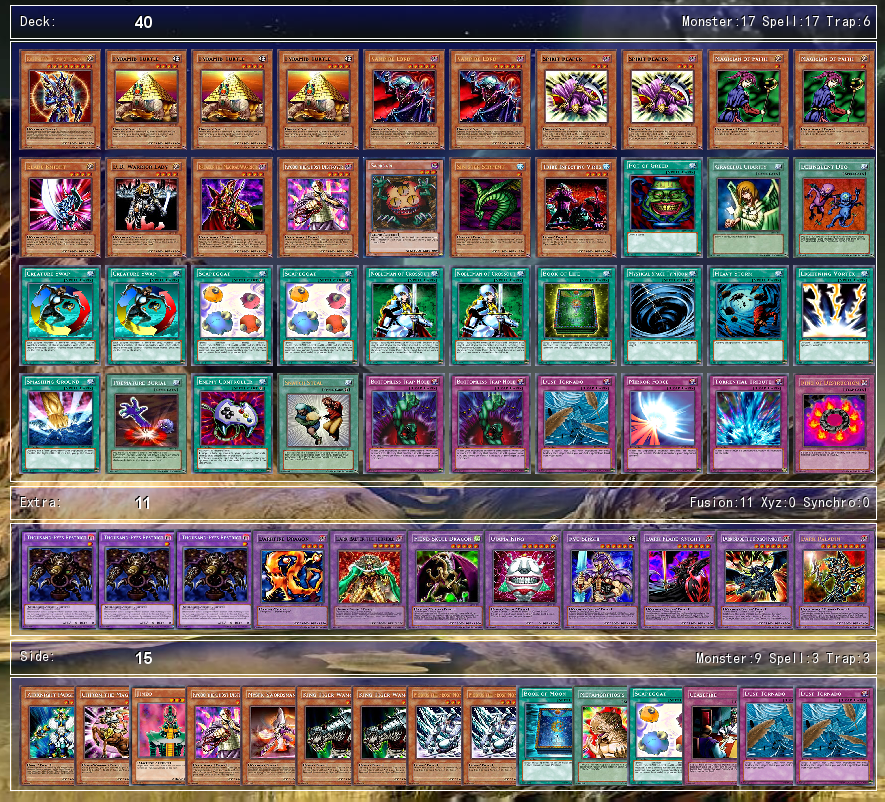
Just as a note on this list, I have cut out most of the Extra Deck monsters used as the deck didn’t focus on Extra Deck plays unlike a Goat Deck (the only way to do this was the single Metamorphosis in the Side Deck). It is also important to note that, as there was no limit on the amount cards players were allowed to place in their Extra Deck back in 2005, it was popular to put nearly every relevant Fusion Monster that existed at the time into one’s Fusion Deck.
The build of Zombies that Eric Wu used at this tournament mostly matches with what the meta relevant Zombie type monsters were at the time. The ratios seen here, of maxing out on Pyramid Turtle along with two copies each of Spirit Reaper and Vampire Lord, helped make sure that the deck can get into its Zombie monsters relatively often without drawing into an excessive amount of Zombie monsters. This was essential as, despite Zombies definitely being the core of the deck, the power cards of the period, such as Delinquent Duo, Black Luster Soldier, and Graceful Charity were still extremely important to draw into as often as possible. Although the deck was definitely a Zombie deck, Wu also had all of the most powerful staple cards that were legal during Goat Format in his deck, something that definitely would help power up any deck.
Wu’s side deck is also interesting to look at as it contains a miniature Goat Control engine, carrying in it the third Scapegoat, a Metamorphosis, and a Book of Moon. His Side Deck also had some standard choices for the time including Ceasefire to allow for easier wins in games that went into overtime as well as King Tiger Wanghu to stop an opponent’s Scapegoat plays.
End of the First Wave
While Zombies had maintained a competitive edge throughout the post Forbidden List period, the loss of Black Luster Soldier proved too difficult for the deck to recover from. While Chaos Sorcerer would serve as a substitute in the successor Chaos deck, the meta shifted away from being entirely Chaos based meaning that the grave disruption Book of Life offered was diminished. The perhaps more difficult meta shift that killed the deck was the introduction of Cyber Dragon. Cyber Dragon supplanted Vampire Lord by being both stronger and much more easily summonable, making it very difficult for Vampire Lord to deal damage.
This wouldn't be the end for Zombies though. The future of Yu-Gi-Oh! would hold further support for Zombies, far more powerful than any support that had preceded it.
The Tactical Evolution of Zombies
Now we’re going to jump ahead two years to the 2007 release of the Tactical Evolution booster set. This set, released at the height of the GX era of the game’s history, saw the introduction of the Gemini monster mechanic, but more importantly it contained two extremely powerful new Zombie support cards. These were Zombie Master and Il Blud. Zombie Master was definitely the more game changing of the two new cards, giving Zombies an easy and type restricted way to revive monsters from the Graveyard much more consistently than normal decks could at the time. The main monsters that were revived using Zombie Master’s effect mainly allowed for the reuse of Pyramid Turtle and Spirit Reaper, both of which helped to maintain constant field advantage.
Il Blud was one of the new Gemini monsters introduced in the set, a set of monsters that are treated as Normal monsters until they are Normal Summoned an additional time. While most of the Gemini monsters that came out in this initial wave of support had very lackluster effects for how difficult it was to actually get them out and re-summon them, Il Blud had no such problems. It was relatively easy to get onto the field despite its high level thanks to Book of Life. For its effect, it could help build up the field with Zombies from both the hand and Graveyard, making it more versatile than Zombie Master.
Both of these new Zombie cards, while definitely powerful, would never have made such a powerful deck were it not for the usage of a little used card that had come out years before: Card of Safe Return. This had the simple effect of letting its controller draw whenever a monster is Special Summoned from the Graveyard, something that was made very easy by all the different ways that Zombies could continually utilize the Graveyard.
Other staple cards that saw use in the deck that complemented its strategy well were Card Trooper, Morphing Jar, and Snipe Hunter. All of these cards helped to fill the Graveyard with monsters, allowing for a revival loop to easily be set up using Zombie Masters and Il Blud along with Book of Life.
The focus of this new incarnation of the deck was on flooding the field with a variety of Zombie monsters through the effects of Zombie Master, Pyramid Turtle, and Il Blud while constantly maintaining hand advantage through the draws that Card of Safe Return gave. While not a particularly complex strategy, it was nonetheless effective, especially in a format where it was much more difficult to make such significant gains in card advantage with minimal setup.
This new wave of support led to the Zombie deck seeing a variety of tops during late 2007. The meta did soon have a massive shift, however, with the release of the Phantom Darkness booster which introduced the infamous Dark Armed Dragon. This did not, however, spell the end for Zombies as this booster also included even more Zombie support in it in the form of Goblin Zombie. Goblin Zombie served as an additional consistency engine that could be played alongside Pyramid Turtle to enable a Zombie player to search out almost any of their key monsters. Dark Armed Dragon himself, of course, also saw play in the deck for those who could afford him due to the deck’s high number of Dark monsters making it an easy card to summon.
Card of Safe Return Zombies Decklists
The first list we will look at is the deck that placed first at Shonen Jump Durham in October of 2007.
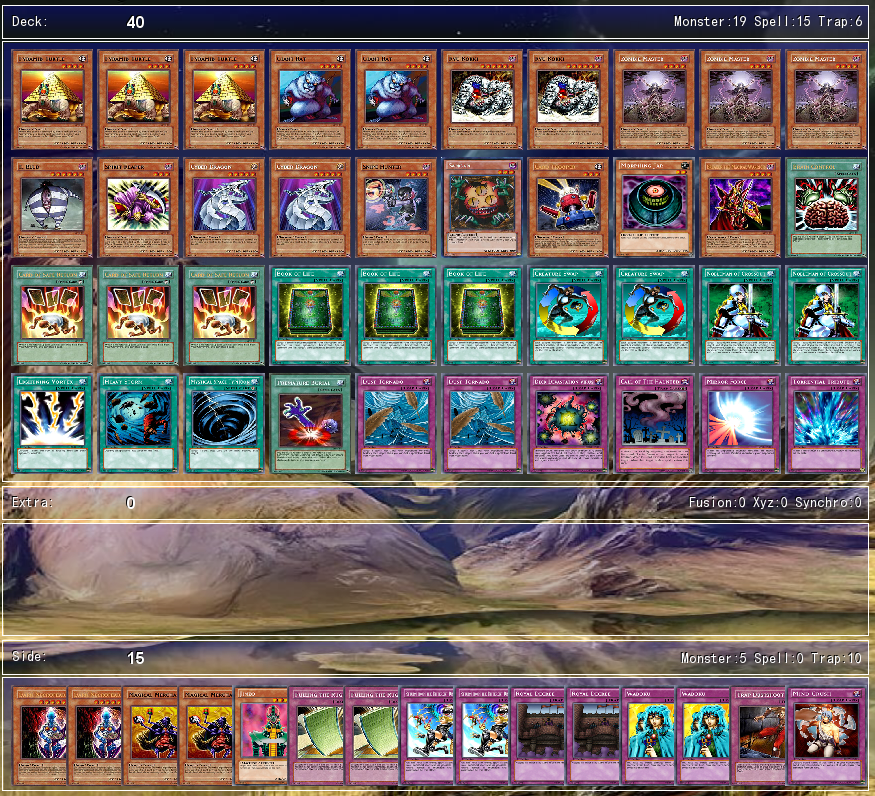
| Deck List | |
|---|---|
| Monsters | Pyramid Turtle x3 Giant Rat x2 Ryu Kokki x2 Zombie Master x3 Il Blud x1 Spirit Reaper x1 Cyber Dragon x2 Snipe Hunter x1 Sangan (Pre-Errata) x1 Card Trooper x1 Morphing Jar x1 Breaker the Magical Warrior x1 |
| Spells | Brain Control x1 Card of Safe Return x3 Book of Life x3 Creature Swap x2 Nobleman of Crossout x2 Lightning Vortex x1 Heavy Storm x1 Mystical Space Typhoon x1 Premature Burial x1 |
| Traps | Dust Tornado x2 Deck Devastation Virus x1 Call of the Haunted x1 Mirror Force x1 Torrential Tribute x1 |
| Side | Dark Necrofear x2 Magical Merchant x2 Jinzo x1 Pulling the Rug x2 Return from the Different Dimension x2 Royal Decree x2 Waboku x2 Trap Dustshoot x1 Mind Crush x1 |
Unlike the previous decklists we’ve been looking at, this decklist focuses a lot more on maxing out on important cards, something that was less vital in the eras of the early game when the focus was more heavily on the large number of powerful Limited cards. The monsters can be relatively evenly split between the searchers (Sangan, Pyramid Turtle, and Giant Rat to summon Pyramid Turtle), the core Zombie monsters, and the staple monsters (Cyber Dragon, Card Trooper, Morphing Jar, Snipe Hunter, and Breaker). The Spell and Trap lineup is relatively standard for what was good at the time, with the notable card unique to Zombies being Deck Devastation Virus. This card was particularly useful in the late 2007 meta due to the popularity of Destiny Heroes and Gadgets, all of which had less than 1500 ATK.
Out of the monsters, Ryu Kokki was particularly relevant as a meta call due to the prevalence of Warrior and Spellcaster type monsters with the popularity of Destiny Heroes and Dark Magician of Chaos at the time.
Also of note is the maxed out copies of Book of Life which, much like in the older Chaos formats, was still extremely relevant due to increasing interaction of decks with the Graveyard as time went on. During the particular format that this deck topped in, the most relevant meta decks all ran Destiny Heroes which heavily interacted with the Graveyard.
The Side Deck, as more themed decks had become the norm by this point, contains a lot more cards specifically targeted at countering particular decks. This can be seen in Pulling the Rug, a card that countered the extremely popular Monarch monsters that saw very widespread usage. Return from the Different Dimension also was relevant as a counter to the anti-meta D.D. decks at the time that focused on using Macro Cosmos and Dimensional Fissure to prevent interaction with the Graveyard, something that was lethal to Zombie decks.
The other deck we’ll be looking at from this format is Nathan Kral’s 3rd-4th place deck from Shonen Jump Minneapolis from April 2008, a tournament that took place right at the height of the Dark Armed Dragon Return format.
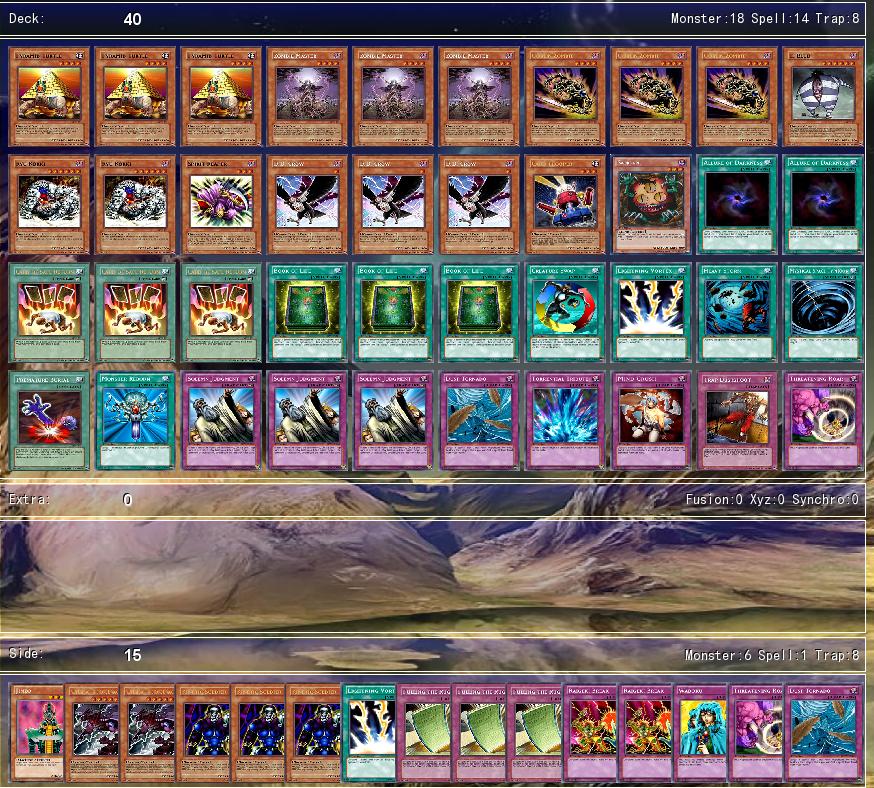
| Deck List | |
|---|---|
| Monsters | Pyramid Turtle x3 Zombie Master x3 Goblin Zombie x3 Il Blud x1 Ryu Kokki x2 Spirit Reaper x1 D.D. Crow x3 Card Trooper x1 Sangan (Pre-Errata) x1 |
| Spells | Allure of Darkness x2 Card of Safe Return x3 Book of Life x3 Creature Swap x1 Lightning Vortex x1 Heavy Storm x1 Mystical Space Typhoon x1 Premature Burial x1 Monster Reborn x1 |
| Traps | Solemn Judgment x3 Dust Tornado x1 Torrential Tribute x1 Mind Crush x1 Trap Dustshoot x1 Threatening Roar x1 |
| Side | Jinzo x1 Van'Dalgyon the Dark Dragon Lord x2 Kinetic Soldier x3 Lightning Vortex x1 Pulling the Rug x3 Raigeki Break x2 Waboku x1 Threatening Roar x1 Dust Tornado x1 |
This list isn’t radically different from the one used a few months prior, but it does have a few key differences worth talking about. First off is the obvious addition of Goblin Zombie which replaced Giant Rat is it more directly served Giant Rat’s purpose while also being a Dark attribute monster. This was now important due to the introduction of Allure of Darkness to help further increase the deck’s consistency. Also of note are the main decked meta calls in the form of D.D. Crow and Solemn Judgment, both run at max copies. These cards served as hard counters to the dominant Dark Armed Dragon deck that encompassed the competitive meta at the time, making the Destiny Hero plays less potent while also making the summoning of Dark Armed Dragon more difficult.
The side deck is also largely the same except for the presence of Van'Dalgyon and Kinetic Soldier. Van’Dalgyon helped make the negations from Pulling the Rug and Solemn Judgment more effective as they trigger a Grave revival upon negating an Effect Monster. This helped to further trigger Card of Safe Return which was still integral to the deck’s strategy.
The Advent of Synchro
While Zombies had managed to weather the changes in the meta that were happening during the late GX era of the game’s history, it would continue to stay relevant when the 5D’s Synchro summoning era started. This was almost entirely due to the fact that Zombies got yet another pair of support cards: Mezuki and Plaguespreader Zombie. Mezuki served as yet another means of summoning Zombies from the Graveyard, making the triggering of Card of Safe Return even easier than it already had been. Plaguespreader Zombie, however, is what truly allowed Zombies to stay relevant into the new era, as it was a Tuner that could also revive itself from the Graveyard.
The most competitive form that this new Zombie support took was very similar to how Zombies entered the meta: combining with the undisputed top deck of the format. While that deck had been Chaos back in 2005, by late 2008, that deck was Tele-DAD. The main advantage the deck had over a normal Tele-DAD deck was the draw engine offered by Card of Safe Return as well as the Zombie specific Synchro monsters, Doomkaiser Dragon and Revived King Ha Des. These additional Synchro options were particularly appealing during the early 5D’s mainly due to the fact that the overall pool of available Synchro monsters was extremely limited at the time.
While this looked like the next incarnation of a seemingly everlasting deck, 2009 would not be kind to the core of Zombie’s strategy. The hits started when Card of Safe Return was Semi-Limited along with Dark Armed Dragon in the September 2008 Forbidden and Limited List, although this merely served as a slap on the wrist for the deck. It continued, however, as both Dark Armed Dragon and Card of Safe Return were Limited in the following list in March 2009. This hurt the deck’s power, but it wasn’t all as the same list Limited Plaguespreader Zombie and Mezuki as well, killing the core engine that had been keeping the deck relevant. The deck took yet more abuse when Card of Safe Return was finally Forbidden in the September 2009 List. This didn’t spell the end for the deck, though, as the same list put Mezuki back to Semi-Limited.
This new incarnation of the deck from late 2009 and early 2010 came to be known as Zombie Synchro. Much like the Dark Armed Dragon variant from late 2008/early 2009, the most recent incarnation of the deck combined the various new Dark support cards, mainly Allure of Darkness and Dark Armed Dragon, together with the key Zombie cards. At this point, the key cards still remained a relatively familiar bunch, consisting of Plaguespreader Zombie, Goblin Zombie, Mezuki, Zombie Master, and Pyramid Turtle. The deck also still had the advantage of the Zombie specific Synchro monsters as well as a variety of consistency cards that allowed the deck to very rapidly fill up the Graveyard. These cards included Foolish Burial which was very potent in the deck and Burial from a Different Dimension which allowed the deck to maintain its resources as well as giving it the ability to abuse the limited number of Mezukis and Plaguespreader Zombies that the deck had access to.
The key difference between Zombie Synchro and the previous incarnation of the deck was the lowered emphasis on Card of Safe Return due to its increasingly harsh hits. Instead, the deck focused on keeping its Graveyard filled and utilizing this ability to continually summon high level Synchro monsters. The core Synchro monsters used at the time were Stardust Dragon, Colossal Fighter, Goyo Guardian, and most importantly Brionac, Dragon of the Ice Barrier. Brionac was one of the most accessible Synchros for the deck, being level 6. In addition to being very easy to summon, it served as a powerful discard outlet and mass removal that was non-destruction, an important feature at the time so as not to trigger an opponent’s Stardust Dragon.
The deck was also very commonly combined at the time with a Destiny HERO engine. This engine normally consisted of about 8-9 cards. These were two Malicious, as it was Semi-Limited at the time, one or two Diamond Dude, one Elemental HERO Stratos to search out the Destiny HERO monsters, and three copies of Destiny Draw, one of the biggest reasons for the engine’s continued popularity. This engine gave Zombie Synchro more consistency by giving both additional Allure of Darkness targets and its own powerful draw engine. Malicious was also a very powerful card as it gave much easier access to the deck’s level 8 Synchro cards than it normally would have.
Zombie Synchro Deck Lists
We will look at two final Zombie deck lists: the first is Kevin Slapnik’s Destiny HERO Zombies that got 2nd place at Shonen Jump Columbus in November of 2009 and Adam Corn who got 3rd-4th place with a Zombie Synchro deck at Shonen Jump Los Angeles in January 2010.
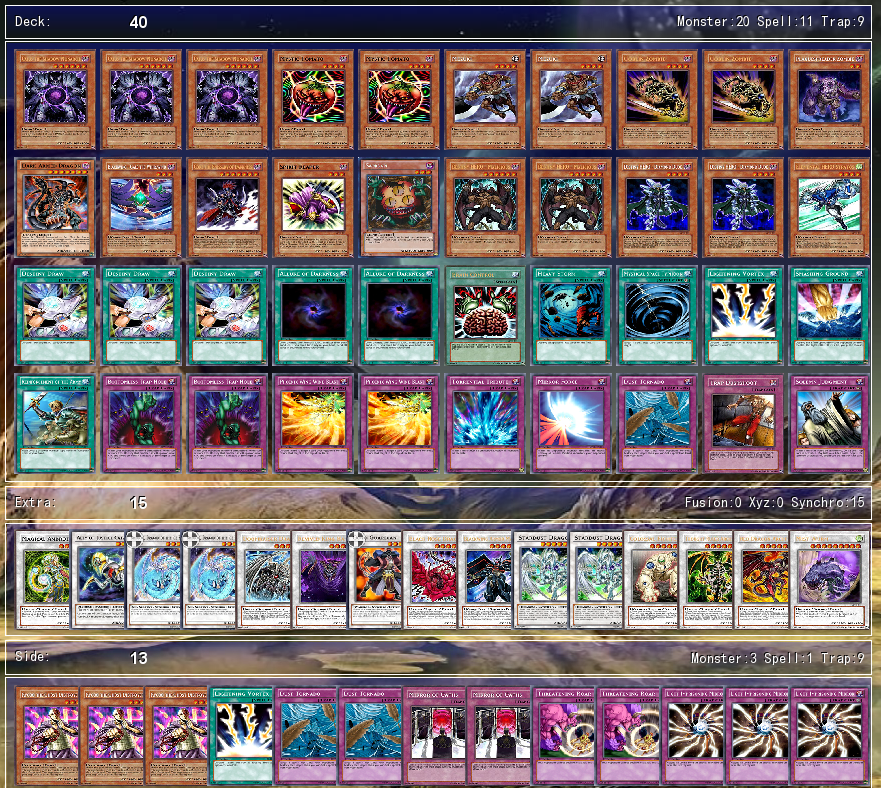
So right off the bat with this list, there are a few key Zombie cards missing from this list. Most notably, the list is missing Zombie Master and Pyramid Turtle, two cards that definitely still saw play at this point in time. It seems from looking at the list that these Zombie cards were largely supplanted by the Destiny HERO engine while still maintaining a full lineup of staple Spell and Trap cards. Something else interesting of note on this list is the usage of Blackwing - Gale the Whirlwind. Despite being a Blackwing monster, this card had surprising synergy with any Dark focused Synchro deck. It served as a target for Allure of Darkness, a utility card for lowering attack, and gave access to Blackwing Armor Master, one of the most powerful Synchro options available at the time.
Looking at the side deck, it is very targeted towards the main dominant decks at the time: Twilight and the mirror match, Zombie Synchro. To that end, Kycoo and Light-Imprisoning Mirror both are hard counters towards Destiny HERO monsters, other Zombie monsters, and Lightsworn. The rest of the Side Deck is mostly focused on standard kinds of Side Deck cards from time that were targeted to stop decks that could flood the board with multiple Synchros, the main decks that did that being Blackwings and Synchro Cat.
Our next deck is Adam Corn’s Zombie Synchro deck.
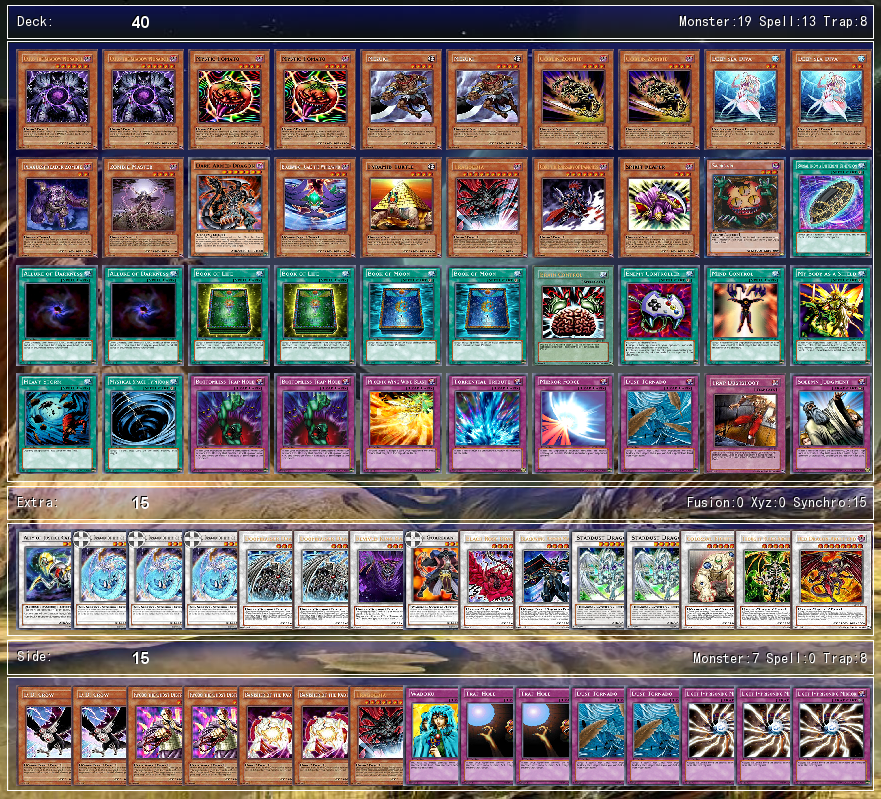
Unlike Slapnik’s deck, Adam Corn’s Zombie Synchro utilized the full lineup of Zombies that were in the meta at the time. A trend that can be seen from this decklist, however, is the prevalence of cards being run at just one or two copies each. This is a departure from how Zombie decks were built during the GX era, but this is largely due to a general shift in deckbuilding back towards running a wider variety of cards instead of maxing out on copies of a few cards. Despite this, the inclusion of Book of Life in this list, a card which had largely left the standard Zombie lists, is notable. The effectiveness of Book of Life in the deck, even in 2010, is very much the same as it was back in the original formats that Zombies were in. Another very interesting tech choice in Corn’s list is Deep Sea Diva which was simply used as an additional Tuner.
The side deck choices that Corn made were largely the same as Slapnik’s, being primarily targeted at Twilight and Zombie Synchro. The main different choice is Banisher of the Radiance as Graveyard hate, even though it would just as equally hurt the Zombie Synchro deck itself.
The Last Days of Zombies and their Continued Legacy
The deck continued to get a sizable number of top showings at Shonen Jump Championships throughout the end of 2009 and early 2010. The deck did, however, finally exit the meta stage in March of 2010 with a blanket set of hits that killed all of the remaining power plays in the deck. These included putting Mezuki back to Limited along with Limits to Allure of Darkness, Burial from a Different Dimension (which had become integral to maintaining the deck’s resources), Foolish Burial, and Destiny Draw. Altogether, these final hits proved to be too much for Zombies to handle, finally killing the deck.
Although more pure Zombie decks fell out of the meta, Plaguespreader Zombie has seen continued usage as a tuner in Chaos based Synchro decks into the modern day. The most popular deck that used Plaguespreader was the Twilight deck that saw usage simultaneously with Zombie Synchro but continued to see play in the meta through the end of the 5D’s era. Zombies even saw a bit of a resurgence, getting scattered regional tops throughout the years, as the various key cards slowly made their way off of the Forbidden and Limited List over time.
Zombies Into the Modern Day
Zombies have also seen a resurgence of sorts since the release of Uni-Zombie in early 2015. This card, combined with Psy-Framelord Omega, allowed Zombies to become a viable rogue deck once again. Things have only gotten better for Zombies since then as the more recent Shiranui archetype is Synchro-focused and composed entirely of Zombie monsters, making it a potent combination. The deck has managed to see several tops as of late 2016 and looks to be able to continue on as a viable Rogue deck. The only threat to this is the potential Limiting of Psy-Framelord Omega, the key Synchro monster in the deck, as this Limit happened to the card in the OCG as of their October 2016 Forbidden and Limited List.
Regardless of any hits they might take in the future, Zombies will always hold their spot as the original competitive type-focused deck and their spot in the hearts of the deck’s many diehard fans.




